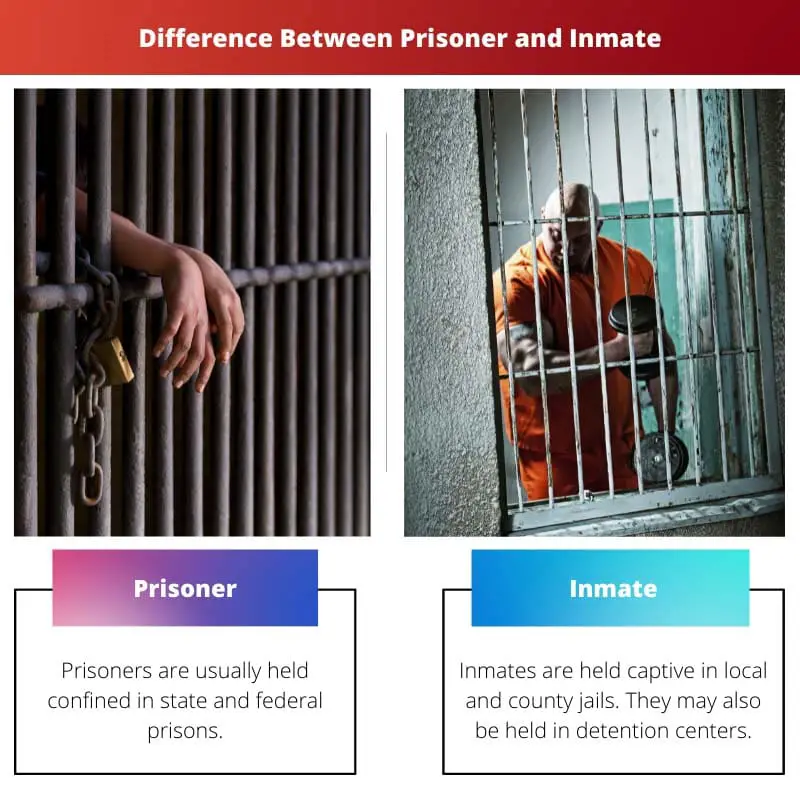A prisoner is an individual confined due to legal sanctions, serving time for a criminal offense. On the other hand, an inmate refers more broadly to someone residing within a correctional facility, encompassing both those awaiting trial and those serving sentences.
Key Takeaways
- A prisoner has been sentenced to serve time in jail or prison, while an inmate is anyone currently living in a prison or jail.
- The term “prisoner” refers to someone convicted of a crime. In contrast, “inmate” can refer to anyone being held in a prison or jail, regardless of whether they have been convicted.
- While both terms refer to incarcerated people, the term “prisoner” carries a more negative connotation, as it implies that the person has committed a crime and been punished for it.
Prisoner vs. Inmate
The difference between prisoners and inmates is that prisoners are people held in jails before their trials occur and their judgment is passed. On the other hand, inmates have been convicted and sentenced to prison life. Prisoners and inmates are both deprived of their right to freedom and held against their will.

Comparison Table
| Feature | Prisoner | Inmate |
|---|---|---|
| Location | Typically confined in state or federal prisons | Typically confined in local jails or detention centers |
| Sentence Length | Usually sentenced to longer terms (over 1 year) | Usually sentenced to shorter terms (less than 1 year) |
| Reason for Confinement | Convicted of a crime | May be awaiting trial, pre-trial detention, or serving a sentence for a minor crime |
| Focus of Facility | Emphasis on punishment and rehabilitation | Emphasis on detention and pre-trial processing |
| Security Level | Generally higher security with stricter rules and regulations | Generally lower security with more relaxed rules |
| Terminology Usage | Often used more generally for anyone incarcerated | Sometimes used specifically for those in jails or detention centers |
What is a Prisoner?
A prisoner is an individual who has been legally convicted of a criminal offense and is serving a sentence of incarceration as a consequence of a court judgment. The term specifically refers to those found guilty of violating established laws and is indicative of their legal status within the criminal justice system.
Legal Status
A prisoner’s legal status is defined by a court decision following a fair and impartial trial. Once convicted, they lose their freedom and are confined to a correctional facility. The legal process involves evidence presentation, legal representation, and a judgment that results in a specific term of imprisonment based on the severity of the offense.
Confinement
Prisoners are physically confined to designated facilities, such as prisons or penitentiaries, as determined by the legal system. This confinement serves both punitive and rehabilitative purposes, aiming to deter further criminal behavior and facilitate the individual’s reintegration into society upon completion of their sentence.
Rehabilitation Opportunities
While incarcerated, prisoners may have access to various rehabilitation programs, including educational courses, vocational training, and counseling services. These initiatives aim to equip them with skills and knowledge that may contribute to their successful reintegration into society, addressing the root causes of criminal behavior.

What is an Inmate?
An inmate is an individual who is confined within a correctional facility as a result of legal proceedings. This term broadly encompasses those who are either awaiting trial or serving a sentence for a criminal offense. Inmates may find themselves in various types of correctional institutions, including jails, prisons, or detention centers, depending on the nature and severity of their legal situation.
Characteristics and Status
Legal Confinement
Inmates have a legal status reflecting their involvement in the criminal justice system. This status may arise from pending charges, awaiting trial, or as a consequence of a court-issued sentence. The term “inmate” emphasizes the individual’s presence within a controlled and supervised environment due to their legal circumstances.
Varied Population
The inmate population is diverse and includes individuals with varying backgrounds, criminal histories, and legal statuses. Some may be first-time offenders, while others might be serving long-term sentences for serious crimes. Additionally, individuals detained pre-trial may still be legally presumed innocent until proven guilty.
Correctional Facilities
Inmates can be housed in a range of correctional facilities, each designed for specific purposes. Jails detain individuals awaiting trial or serving short-term sentences, while prisons accommodate those serving more extended sentences for serious offenses. The term “inmate” thus encompasses individuals across this spectrum of correctional institutions.
Life as an Inmate
Daily Routine
Inmates follow a structured daily routine within the correctional facility, including designated times for meals, recreation, and work assignments. The specific routine may vary depending on the facility’s security level and the individual’s legal status.
Rehabilitation Programs
Correctional institutions provide rehabilitation programs aimed at addressing underlying issues that may contribute to criminal behavior. Inmates may have access to educational opportunities, vocational training, counseling, or substance abuse programs, depending on the facility’s resources.
Challenges and Legal Rights
Inmates face numerous challenges, including limited personal freedom, potential security risks, and restrictions on communication. However, they also retain certain legal rights, such as protection from cruel and unusual punishment, access to medical care, and opportunities to appeal their convictions or sentences.

Main Differences Between Prisoners and Inmates
- Legal Status:
- Prisoners: Emphasizes individuals serving sentences for criminal offenses.
- Inmates: Encompasses a broader group, including those awaiting trial or serving sentences.
- Scope:
- Prisoners: Specifically refers to those in a penitentiary setting.
- Inmates: Encompasses individuals in various correctional facilities, such as jails, prisons, or detention centers.
- Usage:
- Prisoners: Often used in a more formal context, highlighting the legal consequence.
- Inmates: Used in a broader sense, considering the diverse population within correctional facilities.





